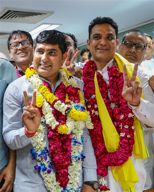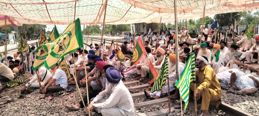
Lighting up hearts: An almost six-decade-old ceremony, it was initially conceived in 1961 to mark Queen Elizabeth II's first state visit to India after Independence Tribune Photos and agencies
Lieut Gen Baljit Singh (retd)
THe sombre and yet flamboyant performances by the bands of the three wings of the defence forces, the Army, the Navy and the Air Force, and pipe bands from the Army, (and since 2016, a massed formation of bands of the Central Armed Police Forces and the Delhi Police), bring to an end the four-day-long Republic Day celebrations on January 29. Those who have never witnessed this magic one-hour event, perhaps among the few such events in the world, should book a seat right away.
The audience comprises several thousand Indians, right from the common man up to the heads of the country’s Legislature, the Executive, the Judiciary, foreign dignitaries and guests from various diplomatic missions. There is a specially created, open amphitheatre near Vijay Chowk where people are expected to be seated 20 minutes before the commencement of the ceremony.
Around this time of the year, a gossamer mist usually softens the sharp edges of the minarets of the South and North Blocks and cloaks the central dome of Rashtrapati Bhavan in velvety smoothness. That is the surreal setting almost every year, when the President of India, who is the chief guest of the event, emerges from one of the grandest presidential residences in the world. He descends down a broad flight of steps, to receive the Presidential Salute from his Mounted Body Guards before alighting the State Coach, drawn by six horses. The coach in itself is a work of art and antiquity of over 90 years. The exterior of the coach, finished in black ebony and trimmed in silver piping, looks spectacular. It is harnessed to black horses (each with a diamond-shaped white birthmark in the middle of forehead), creates a grand contrast as majestic-looking animals go trotting over the brick-red pathway.
In clock-work precision, two posses of eight trumpeters (four from the Army and two each from the Navy and the Air Force), in ceremonial full dress, signal the passage of the cavalcade in between the North and South Blocks, first with a ‘Fanfare of Trumpets’ followed moments later by the music score, “Herald the Chief”. The statuesquely trumpeters, beneath the domes surmounting the two domineering towers of North and South Blocks, directly above the Vijay Chowk, look quite captivating.
Adding to the ceremonial ambience is a picked contingent from the President’s Mounted Body Guard, attired in scarlet tunics, intricately worked with gold lace and contrasting, white mole-skin breeches, astride well groomed and manicured horses. It is a tradition that goes back to the Madras Governor General’s Guard, raised way back in 1773. The Commandant of the Guard, facing the President, orders the National Salute and the massed bands strike up the National Anthem as the Tricolour is hoisted at the venue. The silent audience bursts in vigorous clapping, with maybe a few misty eyes here and there and almost every face wearing a broad smile, symbolic of the enduring spirit of India.
Over the next forty-five minutes, the audience cannot help but tapping their feet to the rhythm of martial music. The underlying theme of every tune is based on patriotism and glory of the Republic, such as “Kadam kadam badhaye chal, khushi ke geet gaya chaal, yeh zindgi hay kaum ki tu kaum par lootaye chal.” As though to fortify this resolve, they next play the rousing “Dhawaj kay rakshak”, (a motivational marching song, with lyrics by Capt Ram Singh and music by Maj HP Brar of the Army). The “Drums Roll”, which follows, creates an auditory crescendo of the thunder and volley and the clash of swords on the battle field.
The ultimate track is a favourite hymn of Mahatma Gandhi. As the sun tips over the horizon, the soldier-bandsmen translate this Biblical hymn into solemn music.
“Abide with me, fast falls the eventide
The darkness deepens Lord, with me abide
When other helpers fail and comforts flee
Help of the helpless, oh, abide with me …”
The Army Music School, which is part of the Army Education Corps, over time have successfully adapted the inherited western martial music to Indian sensibilities. Of late, they even showcase a few de novo music scores using instruments unknown to martial music, such as the tabla, sitar, violin, flute, oboe and even jaltarang. These orchestra creations are remarkably pleasing and the “Salam to the soldier” in particularly, is quite stirring. However, none of them classify as the martial music to march to.
As the “Last Post” is played, and the National Flag is lowered, some four hundred battle-inoculated, soldier-bandsmen wearing immaculate ceremonial uniforms, symbolising their loyalty to the country and a heritage of valour, march up the Raj Path playing to perfection …
“Saare Jahaan Se Accha
Hindustaan Hamaara
Ham Bulbulain Hai Is Ki,
Yeh Gulsitaan Hamaara …”
As though to underline this feeling, the Rashtrapati Bhavan, North and South Blocks, Houses of Parliament are floodlit. Simultaneously, the lotus fountains at Vijay Chowk cascade water in the colours of the National Flag, embodying the idea of India and spirit of Indians.
A colonial legacy
The Beating Retreat ceremony, grand finale to the Republic Day celebrations, was the brain child of India's first Prime Minister, Pandit Jawahar Lal Nehru. It began in 1961. The idea was occasioned by the first state visit of Queen Elizabeth II and Prince Philip after Independence.As the British monarchy is intimately associated with military ranks, uniforms and ceremonials, the Indian Army was given the task of developing a display by the massed bands of the Army, the Air Force and the Navy consisting of pipes, drums, buglers and trumpeters from various regiments. The colourful ceremony has since become an annual official practice with the President of India as its chief guest



























